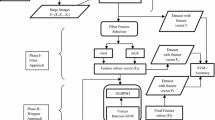Abstract
Image steganalysis is the task of discovering the hidden message in a multimedia file in which the steganalysis technique highly depends on the feature elements of the image. Since there is a possibility for a feature vector to contain redundant elements, processing of redundant elements can be harmful in terms of long computation cost and large storage space. This paper proposes a new feature selection approach based on Adaptive inertia weight-based Particle Swarm Optimization (APSO) for the image steganalysis where the inertia weight of PSO is adaptively adjusted using the swarm diameter, average distance of particles around the center and average speed of particles towards the center. Also, the proposed APSO is used with the novel measure of Area Under the receiver operating characteristics Curve (AUC) as the fitness function to enhance the performance of identification of stego-images from the cover images in steganalysis problem. Due to appropriate convergence rate and the regulated search step of APSO, it is able to select the most significant and influential feature elements and so, the performance of steganalysis will be improved. Experimental results of the proposed method on Breaking Out Steganography System (BOSS) benchmark proves the superiority of the proposed method compared to the similar approaches in image steganalysis in terms of detection of stego-image, running time, and diversity measure.








Similar content being viewed by others
References
Ghareh Mohammadi F, Saniee Abadeh M (2014) Image steganalysis using a bee colony based feature selection algorithm. Eng Appl Artif Intell 31:35–43
Dorigo M, Birattari M, Stützle T (2006) Ant colony optimization. IEEE Comput Intell Mag 1(4):28–39
Karaboga D, Basturk B (2007) Artificial bee colony (ABC) optimization algorithm for solving constrained optimization problems. In: Foundations of fuzzy logic and soft computing. Springer, Berlin, Heidelberg, pp 789–798
Li LX, Shao ZJ, Qian JX (2002) An optimizing method based on autonomous animate: fish swarm algorithm. Proceeding of system engineering theory and practice, pp 32–38
Kennedy J, Eberhart RC (1995) Particle swarm optimization. IEEE international conference on neural network, pp 1942– 1948
Kodovsky J, Fridrich J (2012) Steganalysis of JPEG images using rich models. Proceedings of SPIE, electronic imaging, media watermarking, security, and forensics XIV
Chen C, Shi YQ (2008) JPEG image steganalysis utilizing both intrablock and interblock correlations. IEEE international symposium on circuits and systems, ISCAS 2008, pp 3029– 3032
Kodovskỳ J, Fridrich J (2009) Calibration revisited. In: Proceedings of the 11th ACM multimedia & security workshop, pp 63– 74
Liu Q (2011) Steganalysis of DCT-embedding based adaptive steganography and YASS. In: Proceedings of the 13th ACM multimedia workshop on multimedia and security, pp 77–86
Pevnỳ T, Fridrich J (2007) Merging Markov and DCT features for multi-class JPEG steganalysis. Proceedings of SPIE, electronic imaging, security, steganography, and watermarking of multimedia contents IX, vol 6505, p 3
Kodovskỳ J, Fridrich J (2011) Steganalysis in high dimensions: fusing classifiers built on random subspaces. Proceedings of SPIE, electronic imaging, security and forensics of multimedia XIII, vol 7880, pp 1–13
Kodovsky J, Fridrich J, Holub V (2012) Ensemble classifiers for steganalysis of digital media. IEEE Trans Inf Forensics Secur 7:432–444
Pevny T, Bas P, Fridrich J (2010) Steganalysis by subtractive pixel adjacency matrix. IEEE Trans Inf Forensics Secur 5:215– 224
Moradi P, Rostami M (2015) A graph theoretic approach for unsupervised feature selection. Eng Appl Artif Intell 44:33– 45
Lal TN, Chapelle O, Weston J, Elisseeff A (2006) Embedded methods feature extraction. Springer, Berlin, Heidelberg, pp 137–165
Fawcett T (2004) ROC graphs: notes and practical considerations for researchers. ReCALL 31(HPL-2003-4):1–38
Zomorodian MJ, Adeli A, Sinaee M, Hashemi S (2012) Improving nearest neighbor classification by elimination of noisy irrelevant features. In: Pan J-S, Chen S-M, Nguyen N (eds) ACIIDS 2012, part II. LNCS (LNAI), vol 7197. Springer, Heidelberg, pp 11–21
Geetha S, Kamaraj N (2010) Optimized image steganalysis through feature selection using MBEGA. arXiv:1008.2824
Filler Bas P, Pevný T (2011) Information hiding. In: 13th international workshop. Springer, New York
Aha DW, Kibler D, Albert MK (1991) Instance-based learning algorithms. Mach Learn 6:37–66
Shalev-Shwartz S, Singer Y, Srebro N, Cotter A (2011) Pegasos: primal estimated sub-gradient solver for SVM. Math Program 127:3–30
Olorunda O, Engelbrecht AP (2008) Measuring exploration/ exploitation in particle swarms using swarm diversity IEEE congress on evolutionary computation, pp 1128–1134
Eberhart RC, Shi Y (2002) Tracking and optimizing dynamic systems with particle swarms Proceedings of the IEEE congress on evolutionary computation, vol 1, pp 94–100
Feng Y, Teng GF, Wang AX, Yao YM (2008) Chaotic inertia weight in particle swarm optimization. In: Proceeding of second IEEE international conference on innovative computing, information and control (ICICIC), p 475
Rostami V, Shahmoradi-Khiavi A (2016) Particle swarm optimization based feature selection with novel fitness function for image steganalysis. In: Proceeding of artificial intelligence and robotics (IRANOPEN), pp 109–114
Chen G, Chen Q, Zhang D, Zhu W (2012) Particle swarm optimization feature selection for image steganalysis. In: Proceeding of fourth international conference on digital home (ICDH), pp 304–308
Karthikeyan M, Arun Kumar V, Janardhanam S, Venkatalakshmi K (2011) Improving robustness against RS steganalysis using particle swarm optimization. In: Proceeding of international conference on computational intelligence and communication networks (CICN), pp 454–459
Adeli A, Ghorbani-Rad A, Zomorodian MJ, Neshat M, Mozaffari S (2012) Improving nearest neighbor classification using particle swarm optimization with novel fitness function. In: International conference on computational collective intelligence. Springer, Berlin, Heidelberg, pp 365–372
Yazdani D, Nasiri B, Sepas-Moghaddam A, Meybodi MR (2013) A novel multi-swarm algorithm for optimization in dynamic environments based on particle swarm optimization. Appl Soft Comput 13(4):2144–2158
Author information
Authors and Affiliations
Corresponding author
Rights and permissions
About this article
Cite this article
Adeli, A., Broumandnia, A. Image steganalysis using improved particle swarm optimization based feature selection. Appl Intell 48, 1609–1622 (2018). https://doi.org/10.1007/s10489-017-0989-x
Published:
Issue Date:
DOI: https://doi.org/10.1007/s10489-017-0989-x




